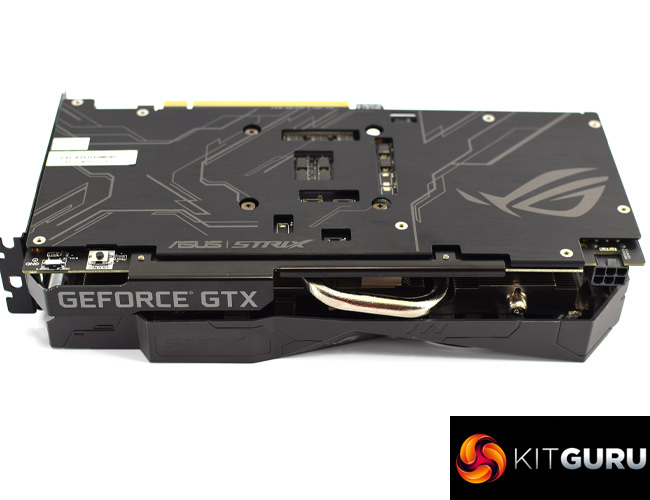As our first GTX 1650 SUPER review, today we have looked at the ASUS ROG Strix GTX 1650 OC edition. It's a high end 1650 SUPER solution, with plenty of features and talking points.
We will start by talking about performance of the GPU. Considering the 1650 SUPER is based on a cut-down GTX 1660 GPU, but with 4GB of GDDR6 memory, we always expected performance to sit closer to the GTX 1660 than the original GTX 1650, and that's exactly how things panned out. Averaged across all of our testing, this 1650 SUPER Strix proved 40% faster than GTX 1650 at 1080p, while it is 9% slower than GTX 1660 at the same resolution.
That means the Strix 1650 SUPER is 5% faster than RX 580, though it is 5% slower than RX 590 and 19% behind the GTX 1660 SUPER – again, all at 1080p. That resolution really is all that can be expected of this new GPU, and it does it well – averaging close to 60FPS in all but two of the games we tested today.
We can't move on from our performance summary without mentioning the 4GB of VRAM. At present, I don't see it as too much of a problem for the card when gaming at 1080p – we were certainly right on the limit in Total War: Three Kingdoms, and a lot of our other games saw reported VRAM usage well over 3GB. Looking at our numbers, I can't say with any confidence that 8GB memory would improve our 1080p performance, but in a year or two that may well be the case.
Certainly, based on our 1440p and 4K testing, performance drops off at higher resolutions versus cards with increased VRAM – RX 590 is just 6% faster at 1080p, but 15% faster at 4K – but we have to remember 1650 SUPER is a product for the budget-conscious gamers out there, so 1080p is definitely its limit.
Looking at the technical performance of this Strix card, I have to say I am incredibly impressed with this model from ASUS ROG. It has dual-BIOS support, allowing you to choose between the P (performance) or Q (quiet) BIOS. The only real difference between the two is that the Q BIOS runs its fans about 500 rpm slower, but it makes a real difference to noise levels – in fact, using the Q BIOS, the Strix has to the quietest graphics card I've ever tested.
Thermal performance is also second to none, with the P BIOS seeing peak GPU temperatures of just 54C, and even the Q BIOS kept the GPU at just 62C, itself an excellent result. The low GPU temperatures also help GPU Boost to keep clocks high, and we saw the card averaging over 1950MHz under load regardless of the BIOS used. From a technical standpoint, this is an absolutely fantastic graphics card.
Based on my prior reviews, that is usually the case with these Strix cards. The drawback simply comes down to pricing. At £200, this GTX 1650 SUPER is actually more expensive than some GTX 1660 cards, while OCUK even has a 1660 SUPER(!) listed for the same price.
That really does make it very simple – despite all its great features, dual-BIOS and excellent cooler, if you can buy a faster card for less money, it really is a no-brainer. I know ASUS is positioning these ROG cards as the premium offerings, but that thinking doesn't work at this end of the market – if you've got £200 or less to spend on a GPU, you're going to want to the fastest one you can get, not a slower card with extra bells and whistles to drive up the price.
If you can find this card on sale, for the same money as other 1650 SUPERs, it is an absolutely fantastic graphics card that will do a great job for 1080p gaming. At £200, though, it simply makes little sense over a GTX 1660 or 1660 SUPER.
If you do want the Strix GTX 1650 SUPER, we found it at Novatech for £199.99 HERE.
Discuss on our Facebook page HERE.
Pros
- Looks good.
- Metal backplate.
- Excellent dual-BIOS implementation.
- Second to none in terms of noise and temperatures.
- Very fast out of the box.
- Faster than RX 580.
- Excellent power efficiency.
Cons
- Simply too expensive for a GTX 1650 SUPER.
- Games are using more and more VRAM at 1080p.
KitGuru says: This is a fantastic graphics card, no doubt about it. It is also too expensive for a GTX 1650 SUPER.
 KitGuru KitGuru.net – Tech News | Hardware News | Hardware Reviews | IOS | Mobile | Gaming | Graphics Cards
KitGuru KitGuru.net – Tech News | Hardware News | Hardware Reviews | IOS | Mobile | Gaming | Graphics Cards




